MailerSend Email Deliverability Guide

- What is email deliverability?
- Why email deliverability matters
- What affects email deliverability
- 1. Email infrastructure
- 2. Email authentication
- 3. Email reputation
- 4. Email content
- 9 ways to improve email deliverability
- Committed to deliverability excellence
- Email deliverability checklist
- Conclusion
Many factors influence deliverability. Fortunately for MailerSend users, our advanced sending infrastructure, continuous monitoring and industry standards all work together to maximize your email deliverability.
But there are a few things that ESPs have no control over—these are the responsibility of the sender. So when emails don’t get delivered, bad sending habits may be the reason why your emails are getting blocked or going to spam.
In this article, we’ll explain why deliverability is important, what affects it, and 9 healthy email habits you can adopt to improve email deliverability rates now.
What is email deliverability?
Email deliverability is your ability to reach the inbox of your recipients. It’s also known as the inbox placement rate, which is the percentage of emails that successfully land in the inbox.
Your email deliverability rate should not be confused with the email delivery rate, the percentage of emails received by your recipients’ email servers. You can enjoy a high email delivery rate, but poor email deliverability as your emails are going to spam.
Why email deliverability matters
Your ability to land in the inbox reflects your standing with mailbox providers like Gmail, Yahoo! Mail and Outlook.com. The sending reputation and domain reputation you build either identifies that you’re a genuine, trustworthy email sender, or that your emails should be singled out for spam.
Email deliverability also affects your brand experience. Customers may get frustrated if they are being asked to check for password reset emails in the spam folder, or they may not return if they are missing order confirmation emails from your WordPress site or WooCommerce store.
What affects email deliverability
Reaching the inbox every time depends on 4 things: infrastructure, authentication, reputation, and content. The responsibility for these is split between your email service provider and you. Let’s visit each one to determine which ones you have control over to improve email deliverability.
1. Email infrastructure
Email infrastructure involves the framework, including hardware and software, that is responsible for ensuring the successful delivery of emails. A reliable email infrastructure consists of various systems that work together to accomplish this, including SMTP servers, IP addresses, feedback loops, mail agents, and sender reputation management tools.
Email servers: Email servers process and validate emails to be delivered to the recipient’s inbox. Before doing this, it verifies that the email is being sent from an active account, that the recipient’s email address is valid, and that the sender reputation is acceptable. MailerSend’s servers do all the heavy lifting of email delivery for you, so you don’t have to worry about managing an email server yourself.
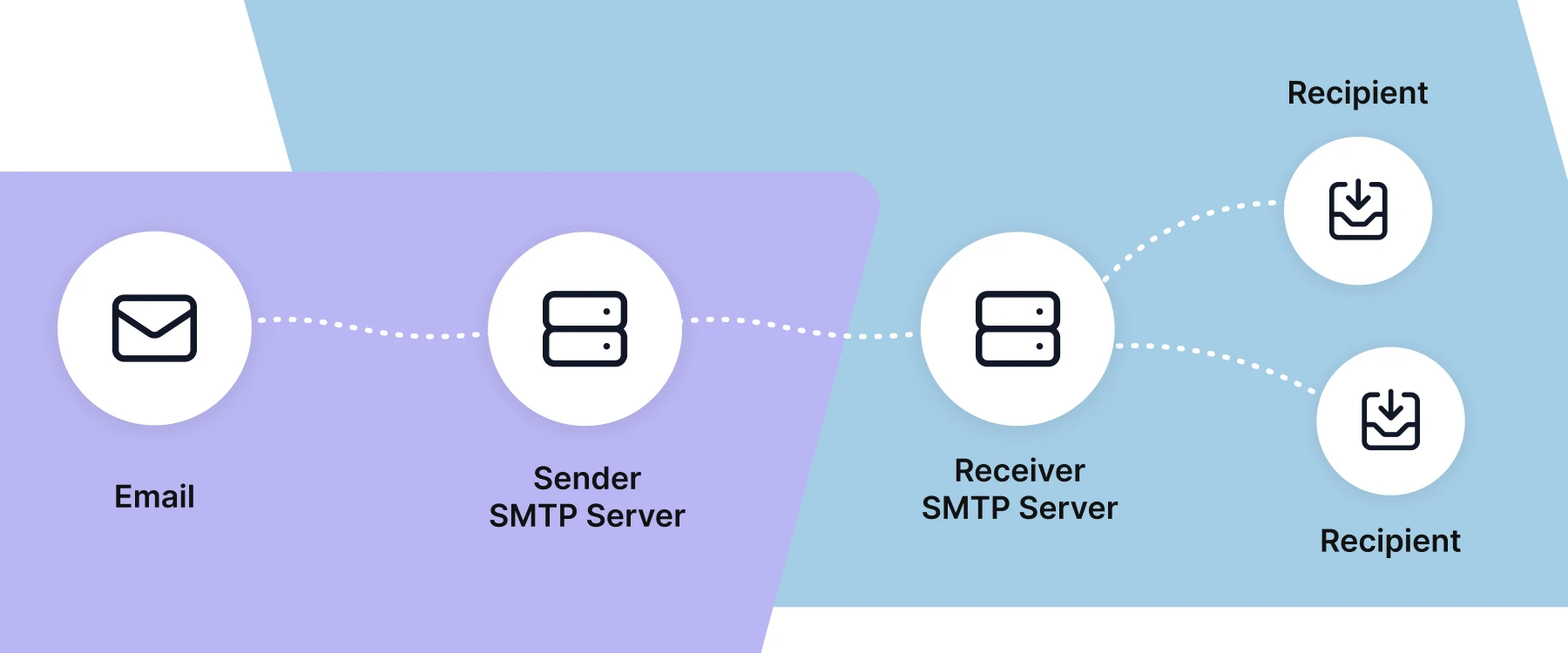
IP addresses: IP reputation plays a considerable role in the deliverability of emails. There are two types of IP addresses: dedicated IP, which is used by a single sender, and shared IP, which is shared by multiple senders. Users have more control over the reputation of dedicated IPs, as the reputation of shared IPs can be affected by the actions of other users. The good news is that MailerSend carefully monitors all activity to ensure IP reputation and deliverability perform at an optimal level, whether you choose a shared or dedicated IP.
Feedback loops: A feedback loop enables senders to get information on spam complaints. This is an important part of email infrastructure. It allows senders to remove recipients that flagged them as spam thus avoiding further spam complaints from them, which in turn makes for increased deliverability. Feedback loops are available from some ISPs, each of which has its own requirements in order to use it. MailerSend takes care of this for users to ensure that feedback is reported in MailerSend analytics, so there is no need to worry about setting up a separate feedback loop for your transactional emails.
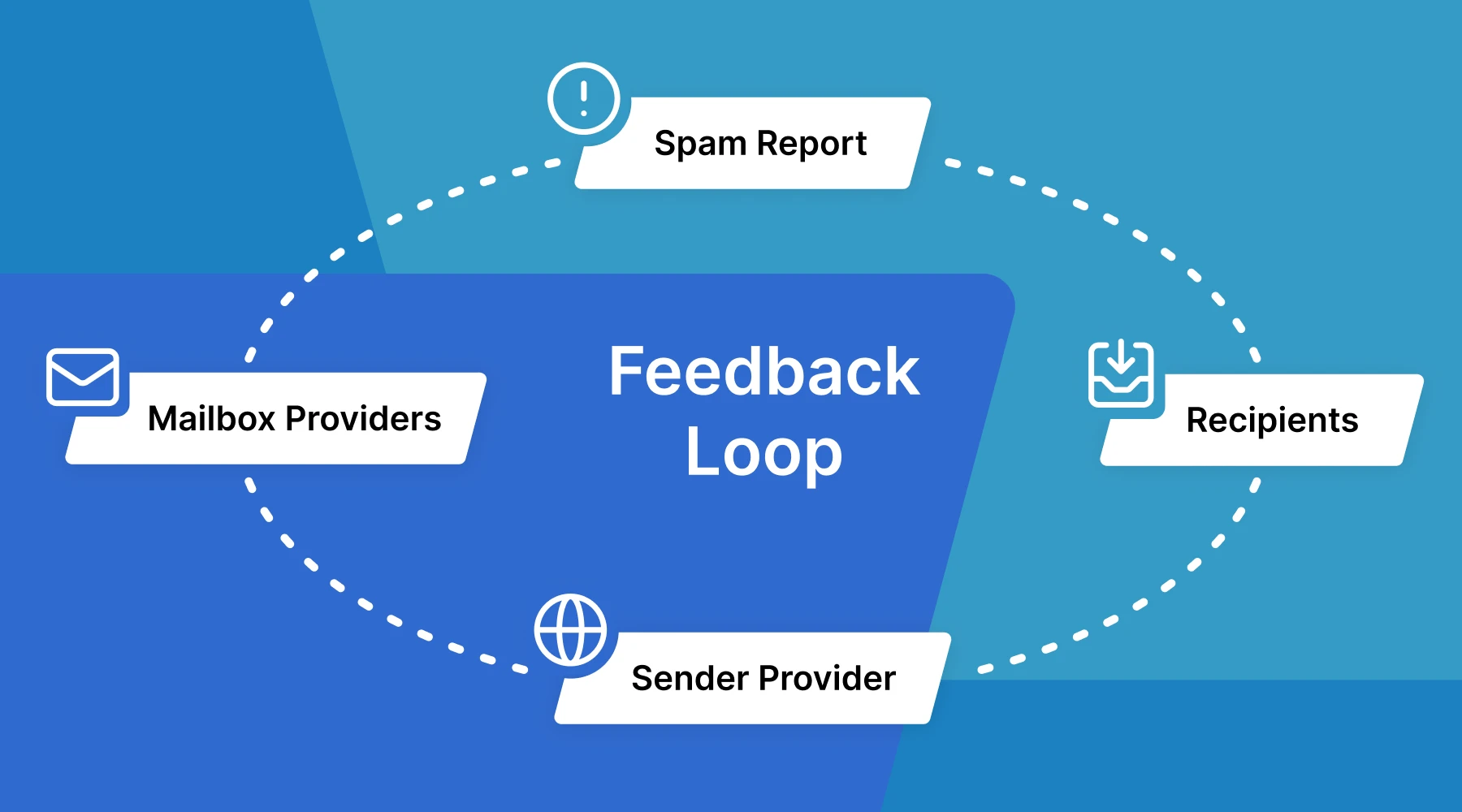
Mail agents: A mail agent enables emails to be transferred, viewed and replied to by the sender and recipient. A good email infrastructure uses different mail agents for different legs of the email’s journey. In a nutshell, the mail user agent refers to email clients (like Gmail, Yahoo and Outlook), or where the email is viewed, replied to, flagged as spam and stored. The mail transfer agent facilitates the transfer of emails between the sender and recipient. The message delivery agent (or local delivery agent) receives the message from the transfer agent and delivers it to the recipient’s inbox.
Sender reputation management tools: This includes analytics and business intelligence tools that email senders can use to monitor performance and optimize their content and strategy to better resonate with recipients and increase engagement. These tools are used for tracking metrics such as click-through rates, monitoring IP reputation, viewing active/inactive recipients, and segmenting audiences.
MailerSend is a leader in deliverability—we ensure that each component of the email infrastructure is built for optimum deliverability. Users have access to inbuilt tools such as email tracking, suppression list management and advanced analytics so they can easily manage their sendings for the best performance, always.
What’s more, you can depend on MailerSend to manage the entire delivery process. In addition to not having to maintain a mail server, you can also be assured of continuous monitoring and optimization by technical teams.
2. Email authentication
Email authentication protocols—like SPF, DKIM and DMARC—help mailbox providers to verify that you are who you claim to be. These look beyond the “From” name and email address in the header to verify that the message originated from the sending domain.
MailerSend helps you improve the email deliverability of your sending domains by requiring that you add SPF and DKIM records to your DNS zone when you set up your account. By authenticating your domain, you are proving ownership and your emails are less likely to go to spam or bounce.
3. Email reputation
Your sender score is a number assigned by major Internet Service Providers (ISPs) to your sending IP address based on various factors. These include bounce rates, their frequency, the volume of emails, and recipient interaction like open rates and click-throughs.
And just like a credit score, the reputation that you have built up can disappear in an instant because of a mistake. A low sender reputation means that your emails are likely to go straight to the spam or junk folders—or not get delivered at all!
You can gain more control over email deliverability by using a dedicated IP address, which is a better option for high-volume senders. However, as you’ll be solely responsible for the dedicated IP’s activity, any action will have a greater impact on reputation, good or bad.
MailerSend helps to protect your sender reputation by automatically adding recipients that reject your emails to your global suppression list.
Whether you choose a shared or dedicated IP, you can protect your sender reputation by adopting good sending habits. If you’re experiencing high bounce rates, for example, you should clean your recipient list to minimize invalid emails and improve how you are collecting recipient emails.
What’s more, you should only send emails to recipients who have signed up for your services (transactional emails) or opted in (marketing emails). As tempting as it may be to purchase an email list to give your audience a quick boost, this is a surefire way to harm your sender reputation with low engagement and spam complaints, and negatively impact deliverability. It’s also illegal, and ESPs simply won’t allow it.
Learn more about why purchasing an email list is a bad idea.
You can improve your deliverability with a dedicated IP: available on demand for large volume accounts with an Enterprise plan. Reach out to our sales team to determine if a dedicated IP is the right fit for your business.
Not sure if a dedicated IP is right for your business? Standard, Professional, and Enterprise users receive premium IP pool management. You’ll share IPs with other high-reputation senders and benefit from well-performing IPs with no need to warm up. Check out our other upgrade features.
4. Email content
Your transactional emails may be unknowingly blocked or go to spam because of your email content. As email gatekeepers, ISPs routinely monitor and filter emails for spam and malicious content before they land in the recipient’s inbox.
Spam filters scan incoming emails in real-time for clues like spammy words, poorly-formed HTML code, and broken links and images. Poor account activation rates, for example, could be explained by blocked welcome emails having the subject line of “YOUR FREE ACCOUNT IS READY”.
To improve email deliverability, you can do your part to regularly review your email content for deliverability red flags like writing mistakes or sending image-only emails. Plus, you can test for deliverability before sending by using an email testing tool, like MailerCheck.
When users create a new account with MailerSend, they must agree to the anti-spam policy, as well as provide details on how they plan to use the service. This ensures that potential spammers are kept at bay.
Additionally, MailerSend monitors accounts for high bounce rates and spam complaints, and enters suspicious accounts into a review process. This prevents any harmful activity from affecting the overall sender reputation, protecting the deliverability of all users.
Now that you know that email authentication, reputation and content are in your hands, here’s an email deliverability guide to 9 ways you can improve your chances of landing in the inbox.
9 ways to improve email deliverability
1. Verify your sending domain
Unverified domains are open to spoofing attacks, where bad actors hijack your domain and use it to send spam and phishing emails. Your email deliverability is greatly affected as your domain is suddenly on blocklists and along with your sender reputation.
Verifying your domain means proving who you say you are to mailbox providers like Gmail and Yahoo. Establishing ownership of the domain also protects you from attacks as it is very difficult to send forged emails that appear to be sent by your brand.
To protect your sender reputation, MailerSend requires that you verify every sending domain before you start sending. The good news is that you only need to verify your domain once to safeguard your brand and give you peace of mind.
When you add a new domain in MailerSend, it automatically generates two important pieces of information to be added to your domain’s DNS records:
SPF (Sender Policy Framework): This is added as a TXT record, and defines the IP addresses that are allowed to send emails for a specific domain. This allows MailerSend to send email messages on your behalf and confirms that you are the owner of the domain’s email address
DKIM (DomainKeys Identified Mailer): This is added as a CNAME record, and adds an encrypted digital signature to emails that can be accessed using the public decryption key defined in the DKIM record in your DNS. It ensures that the content in your email was not changed or tampered with during the sending process
Return-Path: This should also be added as a CNAME record. It specifies the address where bounces and other feedback is sent to. It’s specified by the Return-Path header in an email.
Additionally, you can also generate a DMARC (Domain-based Message Authentication, Reporting & Conformance) record. This isn’t required but is highly recommended to boost security and improve deliverability. It builds on SPF and DKIM, providing a framework for handling failed checks and receiving feedback. Learn more and generate your own DMARC record.
How secure is your email identity? Use the free MailerTest tool to check your SPF, DKIM, DMARC and email headers, so you can protect your business and domain from email scammers.
2. Don’t mix up emails
Mixing promotional and transactional emails can adversely affect your email deliverability. In addition to confusing mailbox providers who classify incoming messages into tabs like Primary and Promotions, you also run the risk of having recipients mark your email as spam.
You don’t need permission to send transactional emails as they are triggered by recipients themselves. However, if you suddenly send newsletters and discount coupons, you must make sure that recipients have opted-in to receive emails like these.
In addition, if you’re emailing EU citizens, the GDPR makes it clear that you are not allowed to insert marketing content into transactional emails. Also, while it may be counter-intuitive to add an unsubscribe link to transactional messages, you should allow EU recipients to control what messages they receive using subscription preferences.
Check out our help guide to learn more about the difference between marketing emails and transactional emails.
3. Avoid spammy behavior
Mailboxes are guarded by spam filters who decide whether your emails land in the inbox—or get filtered to the junk or spam folder. You may be unknowingly using spam-like words or practicing spammy behavior that raises deliverability red flags.
You can ensure that your emails land in the inbox by acting like a good sender. Spam filters like SpamAssassin use sophisticated algorithms to decide if you’re acting like a spammer, including these:
Looking for spam trigger phrases like “100% satisfaction guaranteed”
Inserting a single large image that contains a spammy message
Images without descriptive ALT text (short for "alternative text")
Learn more about the inner workings of SpamAssassin, including how it calculates a spam score using 700 tests! Read more.
4. Get real and personal
Spam filters work in the place of real humans to decide, in real-time, whether you really know your recipients. Emails that get marked as spam are typically impersonal messages sent to a recipient list that was purchased or harvested from the web.
By using your real name or a consistent brand name in all your emails, your open rates will improve, your spam complaint rate will decrease, and you will enjoy better deliverability rates as you build your sender reputation with email providers.
Start getting personal by using a recognizable email like yourname@yourdomain.com. Then personalize your message using variables in dynamic email templates to show that you have a relationship with your recipient and that they are expecting your email.
Get started on email personalization in MailerSend with this help guide, including steps on how to use personalization with the email API.
To further demonstrate to mailbox providers that you’re a genuine sender, include your business details in the email footer or signature. Adding a company logo, a physical address and a contact telephone number will make your emails look more credible to spam filters.
5. Clean your recipient list
Email marketers regularly clean their subscriber list because they know that poor list hygiene and spam traps will affect their email campaigns and thus conversion rates. Metrics like bounces, spam complaints and unsubscribes hurt their sender reputation.
Similarly, you should clean your recipient list as well. Use email suppression lists in MailerSend to automatically collect hard bounces, spam complaints and unsubscribes. Then protect your sender reputation by ensuring you don’t email these recipients again.
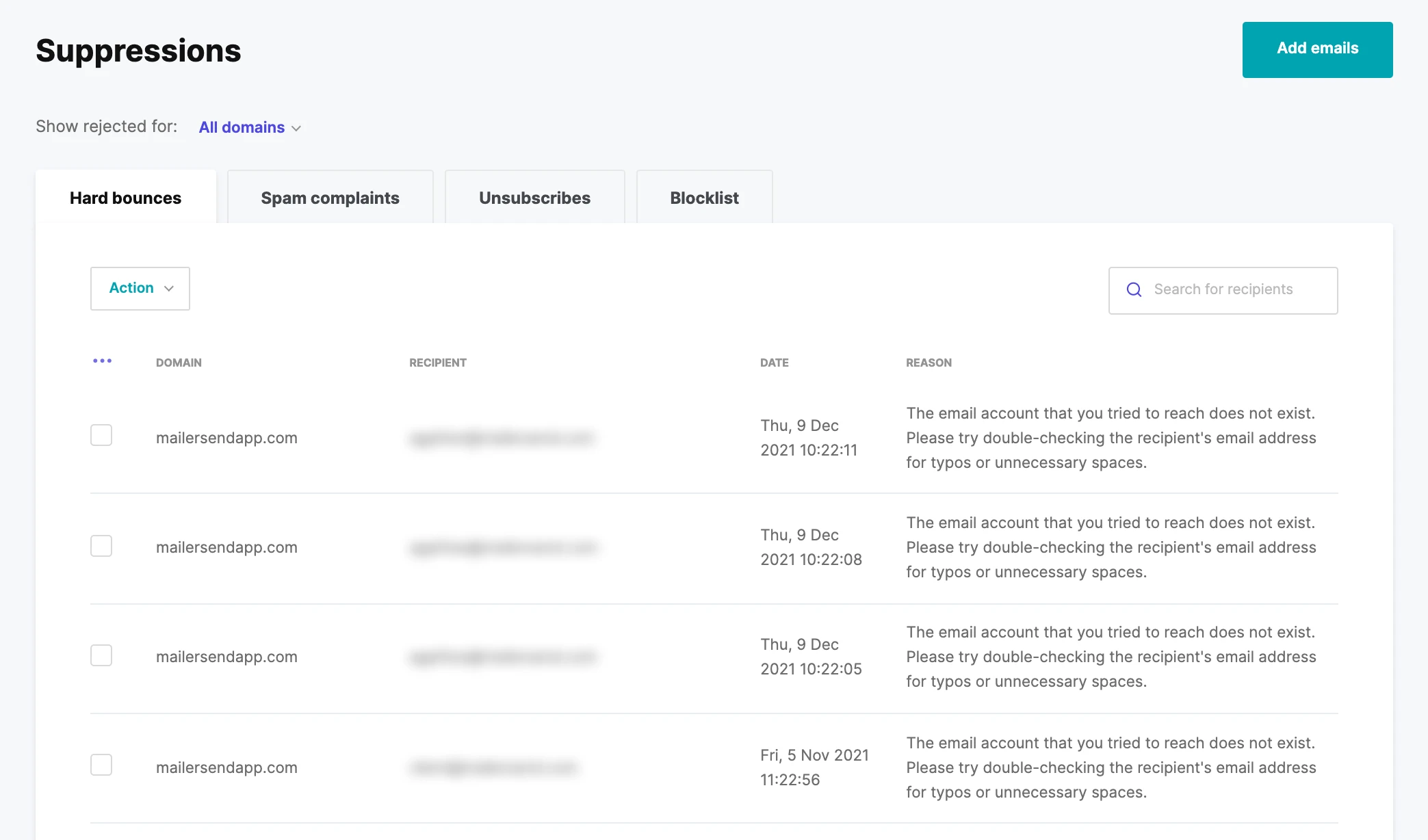
Next, use an email validation tool, such as MailerCheck, to verify your recipient list. Identify invalid emails like soft bounces due to full inboxes, as well as catch-all domains and other invalid emails that you should not be contacting.
Finally, take another look at how you collect email addresses. You can prevent future deliverability issues with invalid emails by verifying them in real-time using an email validation API.
We’re working on an integration with MailerCheck! Check out our roadmap and sign up for our newsletter to be notified when this integration is released! In the meantime, you can integrate MailerSend with MailerCheck with Zapier or Integromat.
6. Proofread email templates
Malicious emails typically contain clues like spelling mistakes, grammatical errors and inconsistent capitalization. While spam filters are unable to understand the content of emails, they can scan your messages using algorithms that look for spam.
Proofread your email templates before sending them. Run your copy through freely available spelling and grammar checkers then get a human to read the final draft. If you’re writing in English, stick to either the US or UK dictionary for consistency and never mix them up.
If you’re sending HTML emails, use MailerSend’s drag & drop builder to produce clean transactional email templates that are clear of broken or deprecated HTML code. As a bonus, their responsive design means they’ll look good on any device used by your recipients!
7. Align sending domains
Multiple domains are sometimes used by businesses, for example: yourdomain-inc.com and yourdomain-intl.com. But if your “From” sender address (name@yourdomain-intl.com) does not match the sending domain (yourdomain-inc.com) your message may be blocked or marked as spam.
For better email deliverability, use domain alignment to build trust with mailbox providers. Matching an authenticated email domain and the domain in the “From” address proves that you are not borrowing someone else’s domain to send emails.
MailerSend implements domain alignment by automatically creating SPF, DKIM and Return-Path records for you. For SPF alignment, the “From” and Return-Path domains must match. For DKIM alignment, the “From” must match the DKIM domain record.
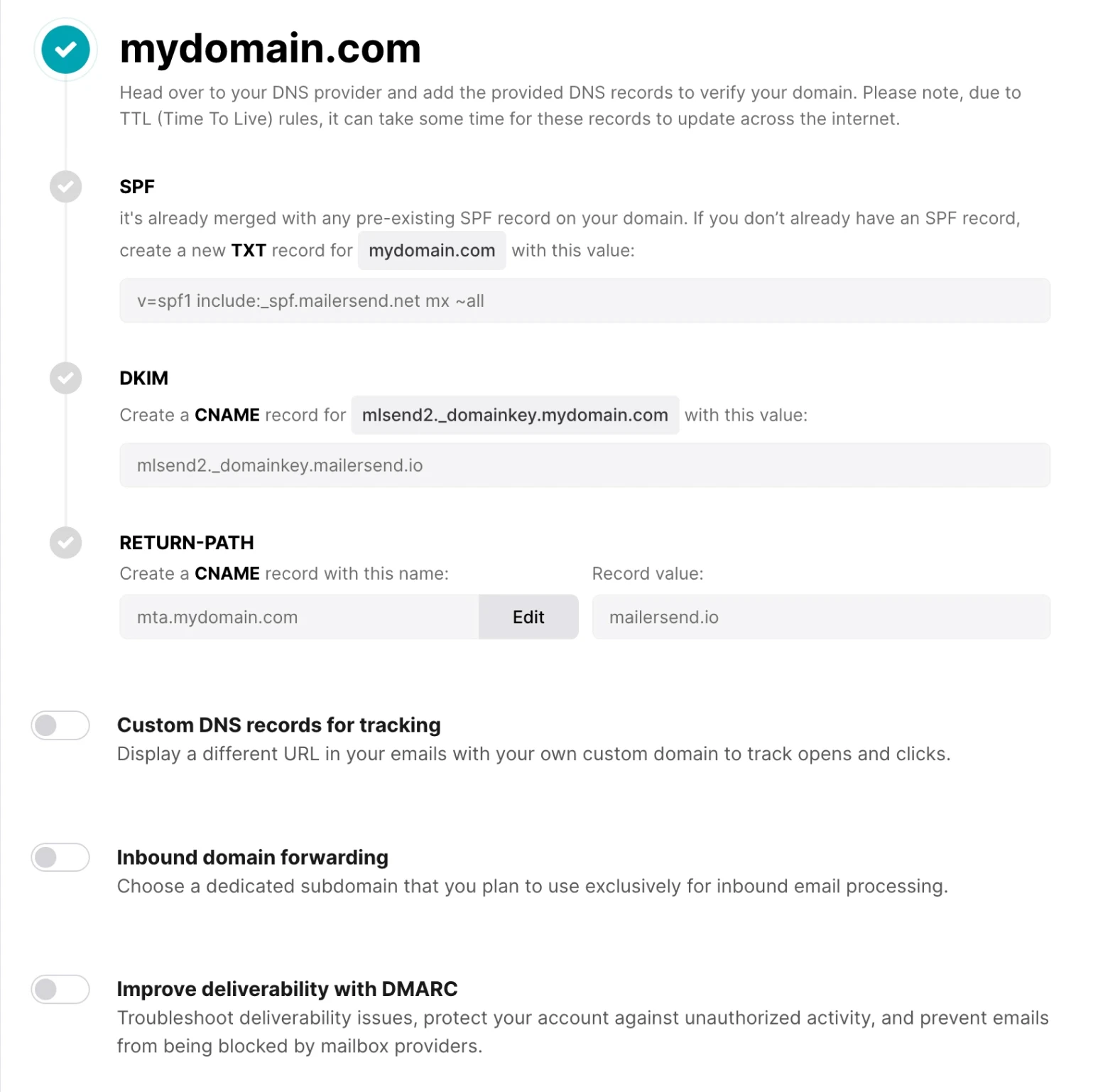
8. Monitor email events
If left unchecked, bounced transactional emails and poor engagement rates from your recipients is a recipe for low deliverability. Hard bounces indicate poor email list hygiene, while low open rates may suggest that recipients are not interested in your email content.
MailerSend’s email analytics can help you take preemptive action to protect your sender reputation. The domain tracking options enable you to monitor opens, clicks and unsubscribes—fixing low click-throughs caused by broken links, for example. Or get push notifications as they happen by setting up webhooks.
You can also get an overview of email activity with the Analytics dashboard. A real-time feed shows you if emails were successfully delivered or bounced. High bounces hurt your sender reputation and you should start cleaning your recipient list.
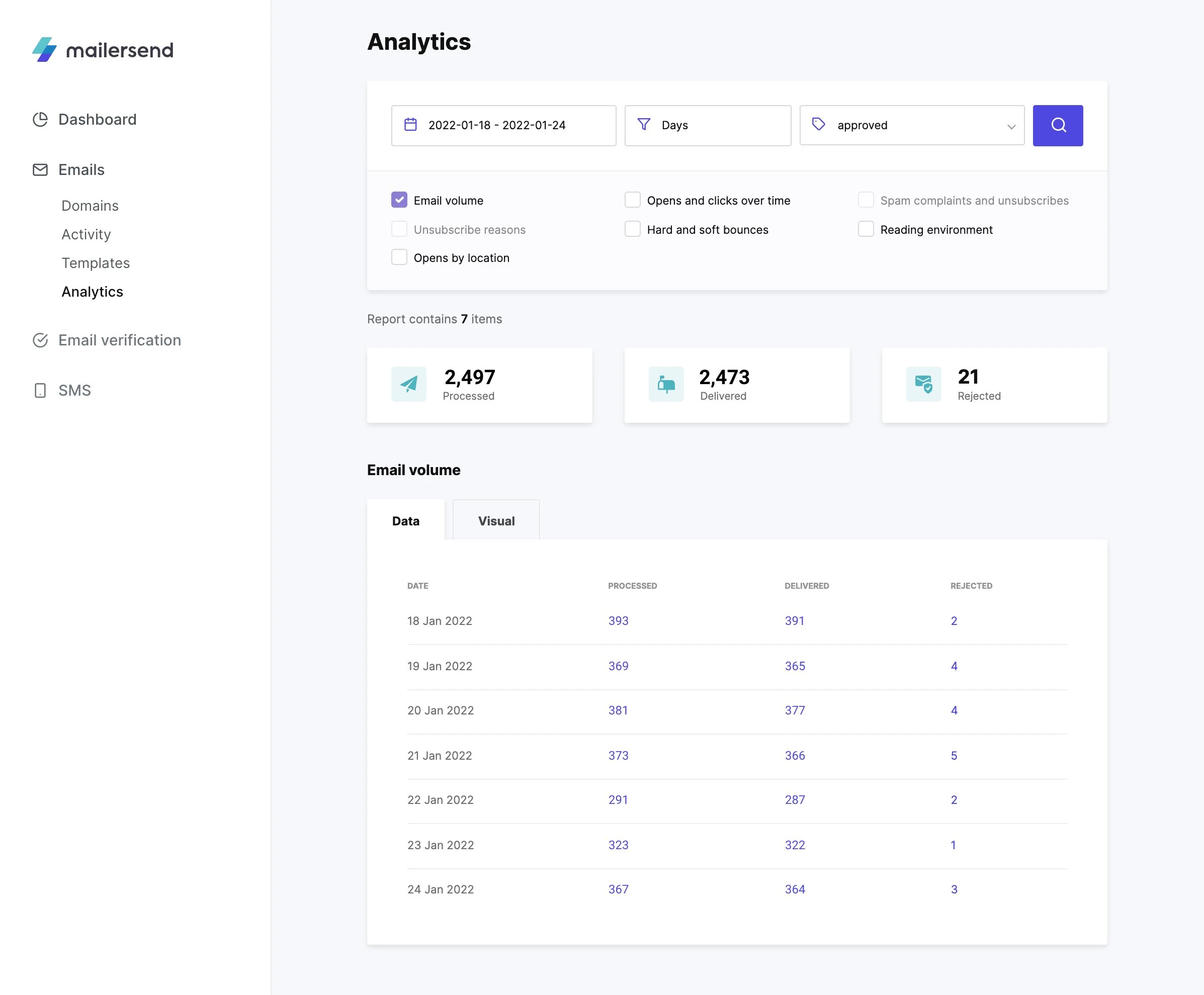
9. Test before sending
So, you’ve implemented these email deliverability best practices—will your efforts land your emails in the inbox? Aside from analyzing email metrics after sending, there’s no way of knowing if you passed the spam filters or went straight to the spam or junk folder.
You can test before sending by using a deliverability tester like MailerCheck. The Email Insights feature provides a detailed report on how your email will be viewed by typical spam filters and what you can do to improve its deliverability.
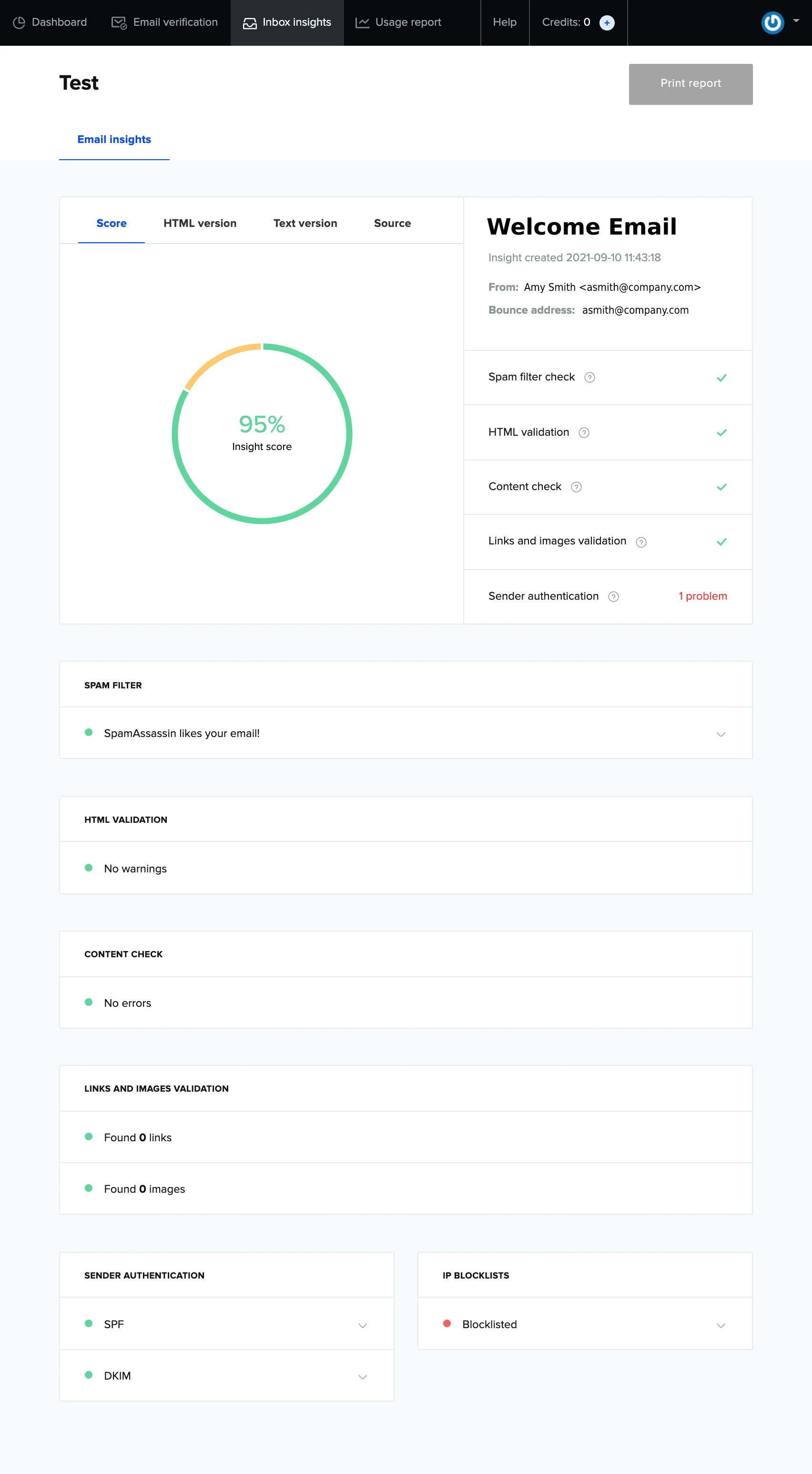
Another functionality, Inbox Placement, gives you a preview of where your emails might land in a mailbox. If your emails are likely to end up in the promotions, junk or spam folders, you can take proactive steps like reviewing your email content again.
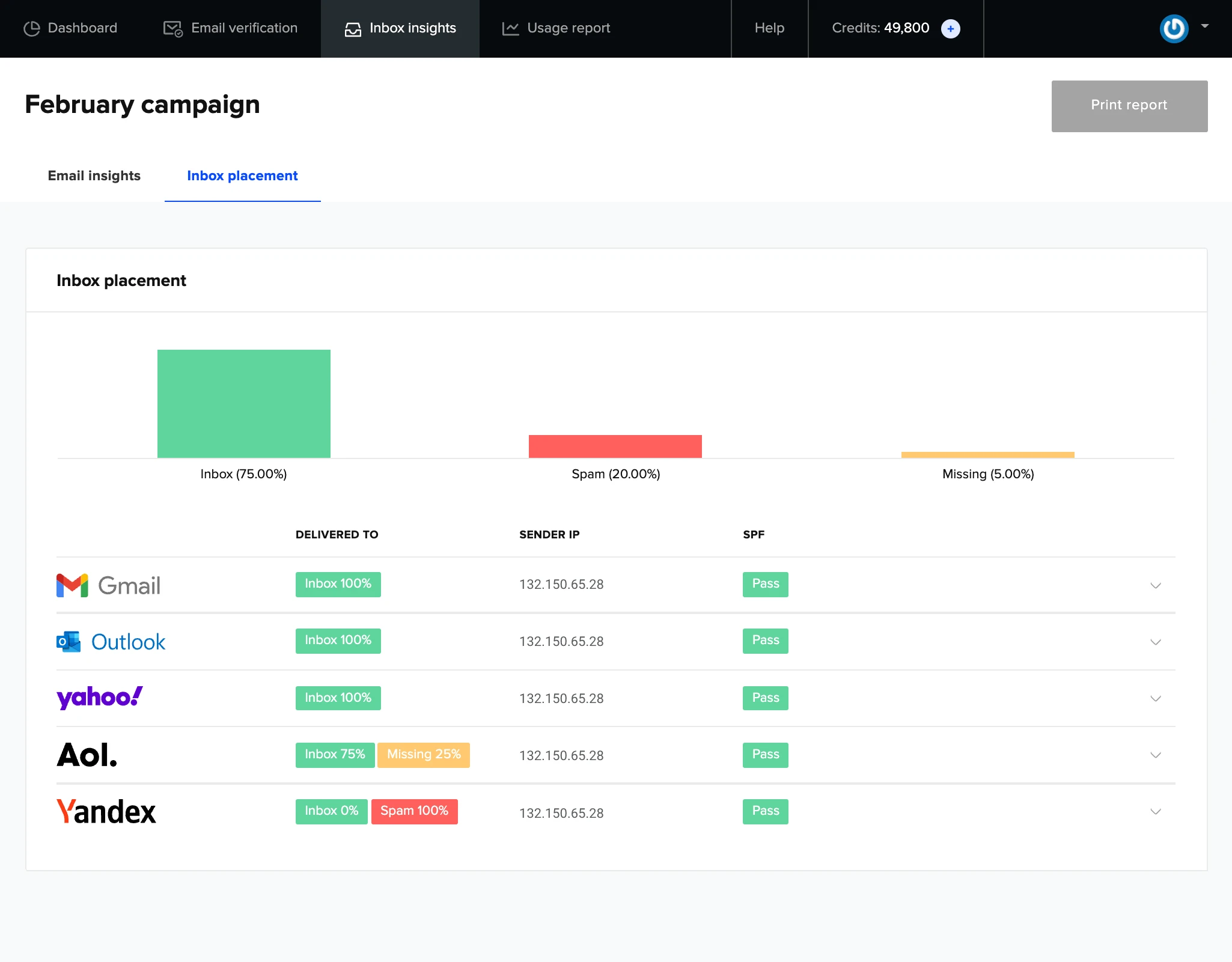
Committed to deliverability excellence
MailerSend is built by deliverability experts, so you can rest easy knowing your emails reach the inbox. What’s more, we’re proud to offer a 99.5% uptime SLA for the best transactional email service possible. It’s all thanks to our amazing team who is committed to deliverability excellence!
To help you on your journey to improving email deliverability, MailerSend has transactional email help articles that are continually updated to reflect best practices. And, if you need a helping hand, email support is available to Hobby plans and above, while Starter accounts and above enjoy chat support.
Email deliverability checklist
To summarize, here’s a checklist of things you can do to improve email deliverability and increase your chances of landing in the inbox.
✅ Authenticate domains
✅ Don’t mix up emails
✅ Avoid spammy behavior
✅ Get real and personal
✅ Clean your recipient list
✅ Proofread email content
✅ Align sending domains
✅ Monitor email events
✅ Test before sending
Take steps to improve deliverability now
Email deliverability requires teamwork between you and your email service provider. You cannot depend on one or the other to reach the inbox if, for example, you have careless sending habits or your transactional email service isn’t optimized for sending. You can improve your deliverability chances by picking a trusted email service provider and following these 10 healthy sending best practices!
Have you put these deliverability best practices into action? Share your thoughts in the comments!



